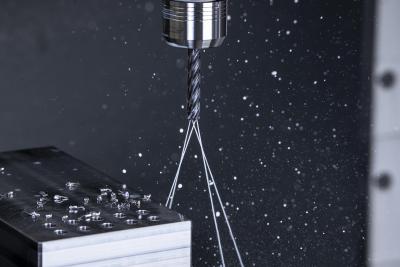
The first of its kind on the market, CERATIZIT USA Inc.’s WTX High-Feed Drill features four effective cutting edges for increased precision, productivity and service life.
The innovative pyramid geometry of the WTX ensures extremely aggressive and precise drilling performance. In fact, the WTX achieves positioning accuracy of 0.03 mm and excellent centering properties. Higher levels of drilling quality, hole tolerance, surface finish, and positioning accuracy increase component quality, to the extent that there is no need for potential reworking. Furthermore, low burr formation when entering and exiting the hole eliminates the need for time-consuming subsequent deburring.
The unique four-flute design of the WTX enables extremely high feeds in steel processing, as well as secure and quick chip removal. The distribution of cutting force to four cutting edges results in longer service life. In addition, four continuous spiral-through coolant holes provide optimum cooling of each cutting edge and contribute to a higher tool service life and a noticeable reduction in tool costs.
The application of impenetrable new CERATIZIT Dragonskin DPX14S coating on the WTX provides maximum protection for the drill and further increases tool life, cutting speeds, and process reliability. Dragonskin utilizes TiAIN nanolayer coating with a .35 coefficient of friction and allows for maximum application temperatures of 1832º F.
Contact Details
Related Glossary Terms
- burr
burr
Stringy portions of material formed on workpiece edges during machining. Often sharp. Can be removed with hand files, abrasive wheels or belts, wire wheels, abrasive-fiber brushes, waterjet equipment or other methods.
- centering
centering
1. Process of locating the center of a workpiece to be mounted on centers. 2. Process of mounting the workpiece concentric to the machine spindle. See centers.
- coolant
coolant
Fluid that reduces temperature buildup at the tool/workpiece interface during machining. Normally takes the form of a liquid such as soluble or chemical mixtures (semisynthetic, synthetic) but can be pressurized air or other gas. Because of water’s ability to absorb great quantities of heat, it is widely used as a coolant and vehicle for various cutting compounds, with the water-to-compound ratio varying with the machining task. See cutting fluid; semisynthetic cutting fluid; soluble-oil cutting fluid; synthetic cutting fluid.
- cutting force
cutting force
Engagement of a tool’s cutting edge with a workpiece generates a cutting force. Such a cutting force combines tangential, feed and radial forces, which can be measured by a dynamometer. Of the three cutting force components, tangential force is the greatest. Tangential force generates torque and accounts for more than 95 percent of the machining power. See dynamometer.
- tolerance
tolerance
Minimum and maximum amount a workpiece dimension is allowed to vary from a set standard and still be acceptable.

